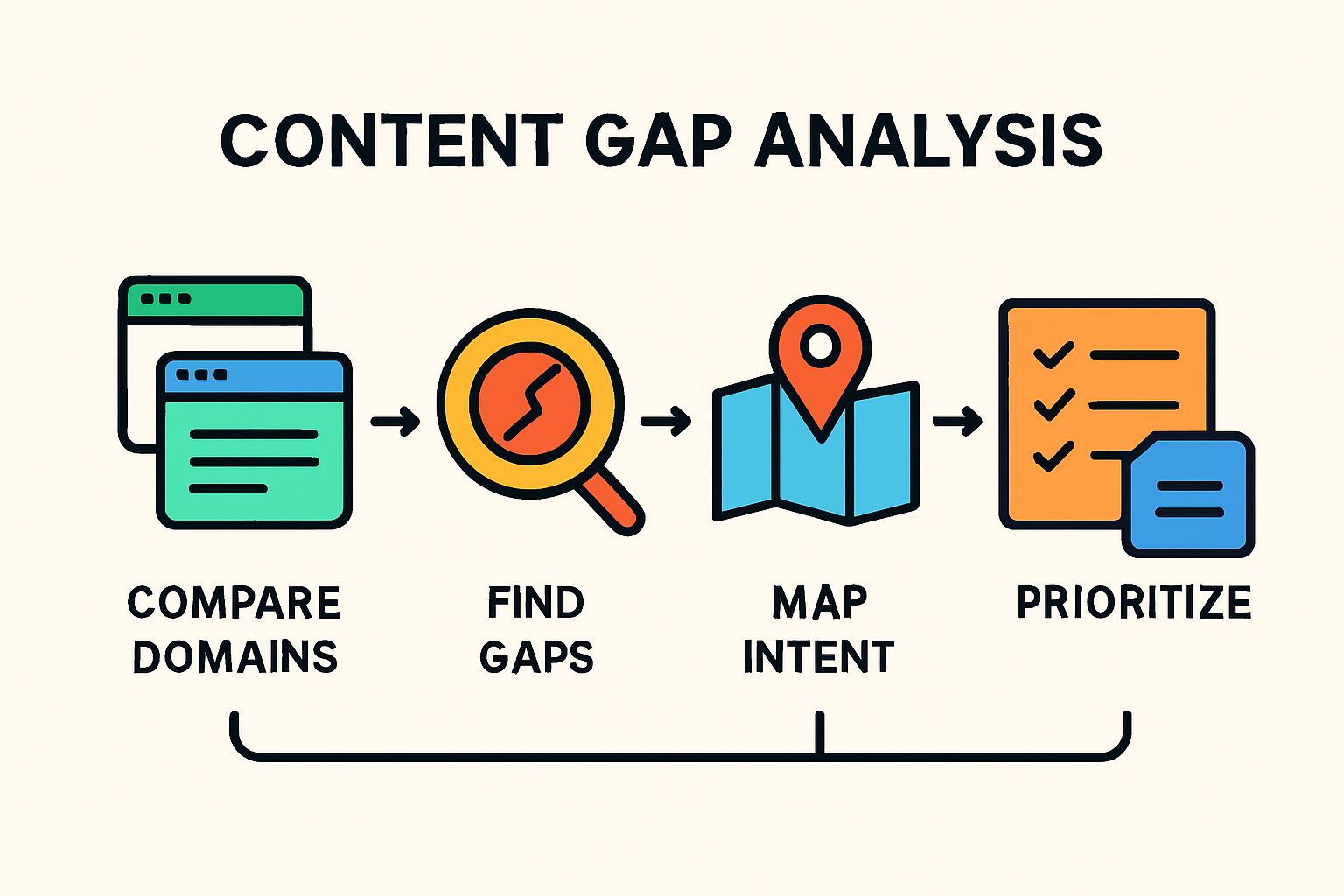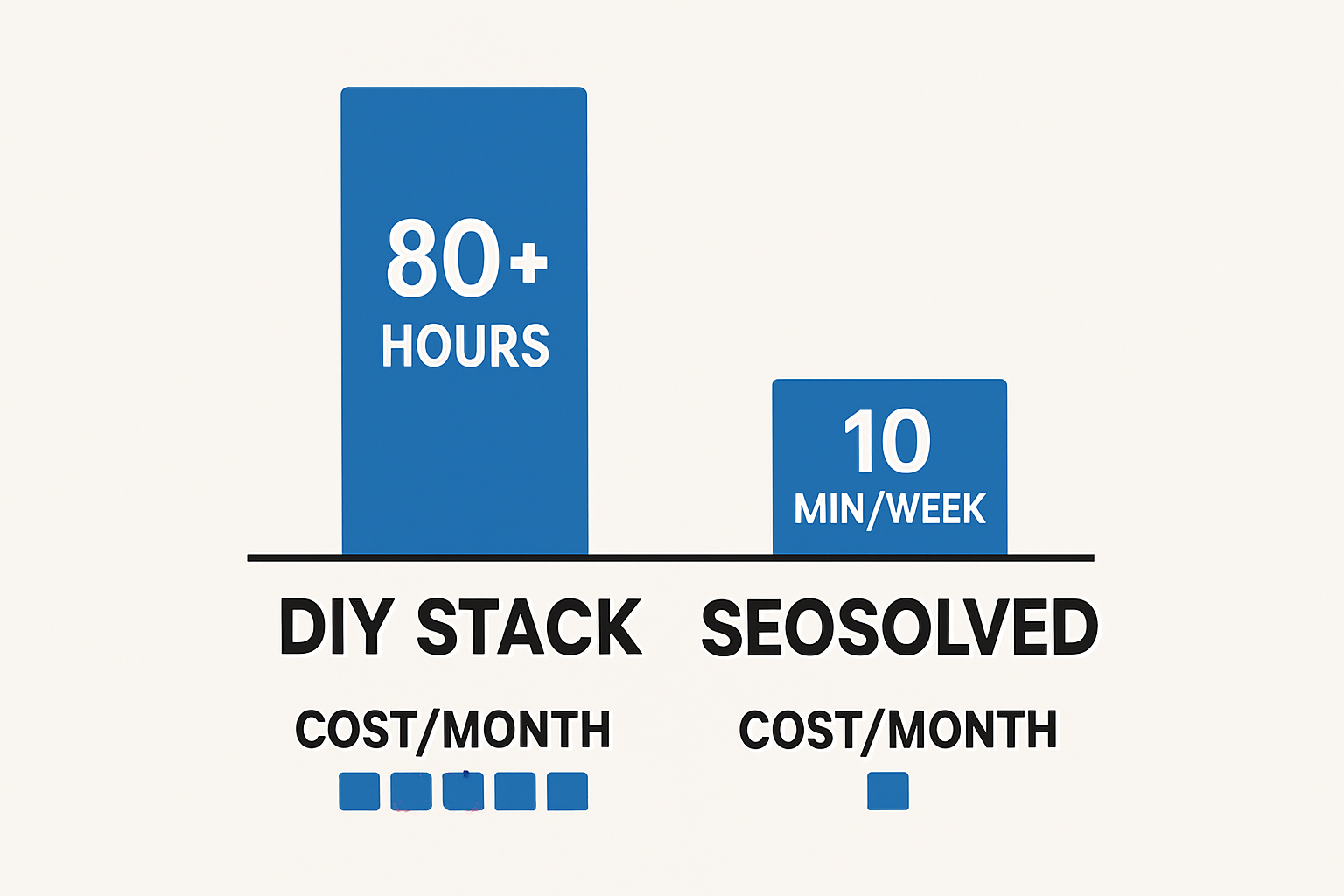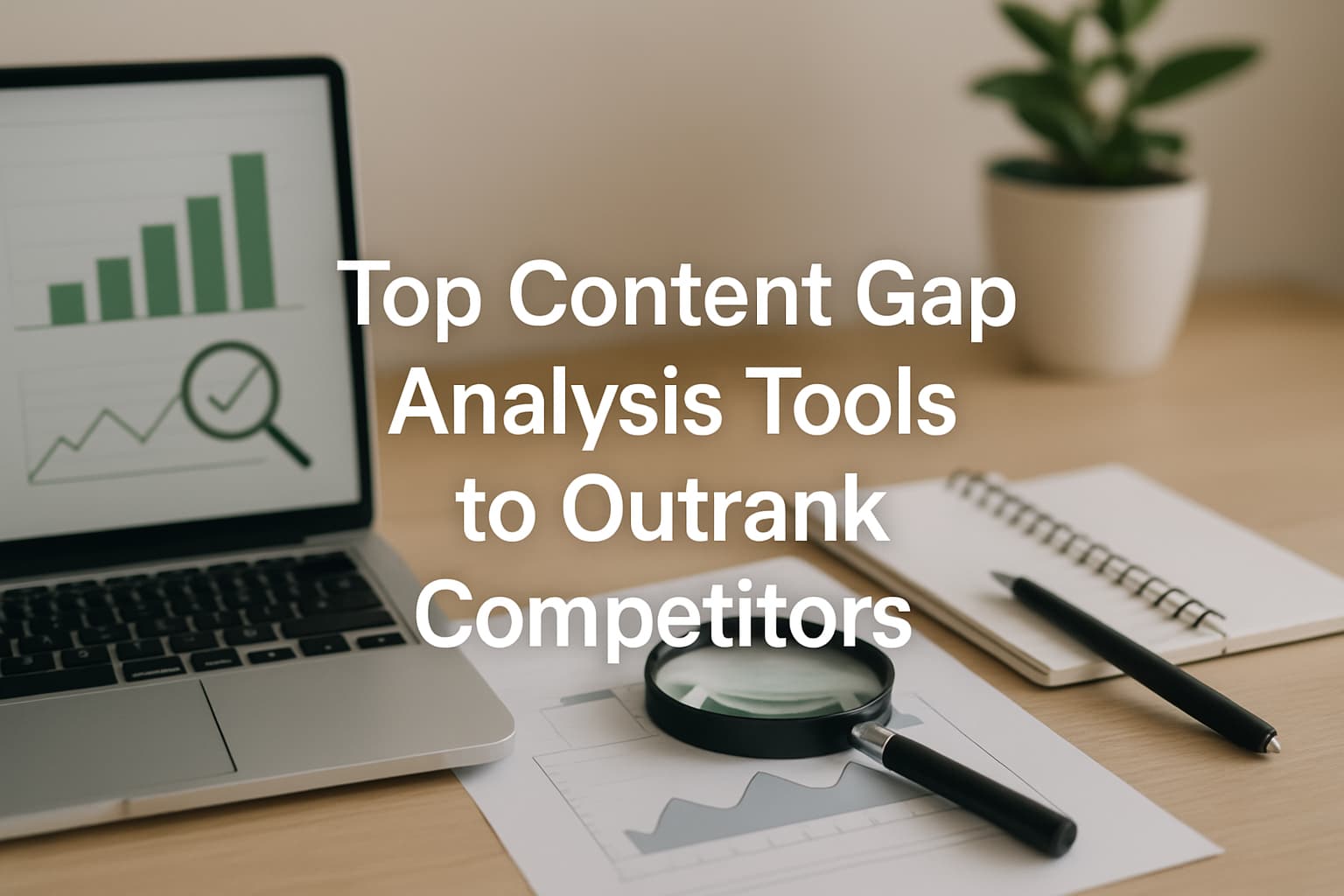If your competitors keep snagging the clicks you deserve, the fix is rarely “more content.” It’s smarter content. The fastest path is using content gap analysis tools to find the exact keywords, topics, and internal links you’re missing—and then closing those gaps with intent-matched pages.
In this guide, you’ll learn what these tools do, how to pick the right stack, step-by-step workflows in popular platforms (including the Semrush Keyword Gap tool), and how to automate the whole pipeline with SEOsolved to go from gaps to published articles—fast.
What content gap analysis tools actually do (and why they matter)
Content gap analysis tools compare your site against true competitors to surface keywords and topics you don’t rank for (or rank weakly), map search intent, and highlight how to improve topical authority. Done well, this directly translates into faster rankings and revenue in 2025.
Key benefits supported by industry guides:
- Boost visibility across search and AI answers by discovering new topics and improving existing content.
- Acquire competitors’ traffic by covering their winning topics better.
- Increase efficiency by turning competitive SEO into a repeatable, idea-rich workflow.
- Improve business results by publishing high-quality content aligned to what your audience actually searches.
Practically, these tools reveal:
- Keyword gaps: queries competitors rank for that you don’t—or where you’re weak.
- Search intent: informational vs. commercial intent to match page types and CTAs.
- Topic authority gaps: entities and subtopics the top SERP pages cover that your content misses.
Quick definition: A content (keyword) gap analysis identifies terms your competitors rank for and you don’t, near-miss rankings you can improve, and opportunities to build topic authority with intent-aligned content.

How to choose: evaluation criteria for the right tool stack
Use this buyer’s checklist to select content gap analysis tools that fit your market, team, and budget:
- Data accuracy & freshness: Reliable US SERP data, broad index coverage, and frequent updates.
- Competitor coverage: Ability to add multiple competitors, including indirect and SERP-only rivals.
- Intent analysis: Filters or labels for informational/commercial intent and SERP features.
- Depth vs. speed: Choose deep crawls and analysis for enterprise, quick insights for SMBs.
- Workflow fit: Exports, tagging, shared projects, and integrations with your CMS/project tools.
- On-site diagnostics: Crawling to find thin content, cannibalization, and internal linking gaps.
- On-page optimization: NLP terms/entities to maximize topical authority and completeness.
- Pricing & seats: Match subscription tiers to your team size and skill level.
Tip: Start lean with one competitive tool, one crawler, and one optimizer—then layer automation as your cadence matures.
Quick picks by use case and budget
Here’s a practical short list based on common goals. Expect trade-offs between breadth, depth, and speed.
Best all-in-one for SMBs focused on quick wins
Semrush offers fast competitive visibility and a friendly interface. Use the Semrush Keyword Gap tool to compare your domain against up to five competitors and pull missing/weak terms in minutes. Good for fast insights and quick-win planning.
Best for deep competitor keyword + backlink gaps
Ahrefs combines a large index with robust competitive comparisons and backlink data. Use Competing Domains to set true competitors, then the Content Gap report to mine precise, high-intent keywords and validate with SERP Overview.
Best free or low-cost stack to get started
Combine Google Search Console (near-miss rankings, CTR gaps) + Google Trends (seasonality, US regional demand). Add freemium tools to compare against top pages and spark ideas before you invest further.
Best for on-site content and internal linking gaps
Screaming Frog or Sitebulb reveal thin content, cannibalization, and internal link opportunities that block rankings. Ideal for fixing the foundation.
Best for on-page optimization and topical completeness
Clearscope, Surfer, or MarketMuse help transform gap keywords into intent-aligned briefs that include must-cover entities and internal link targets to build topical authority.
Tool-by-tool walkthroughs: how to run a content gap analysis
Follow these step-by-step workflows to replicate results today.
SEMrush Keyword Gap tool: find missing and weak keywords fast
Use the semrush keyword gap tool to quickly surface where competitors outrank you.
- Open Keyword Gap and enter your domain plus up to five competitors.
- Set the database to your target market (e.g., United States).
- Filter by Missing and Weak to focus on gaps and easy upgrades.
- Apply intent filters to split informational vs. commercial queries.
- Sort by volume, traffic potential, or difficulty to prioritize.
- Export to CSV and tag themes (e.g., pricing, how-tos, comparisons).
Pro tip: Pair with a quick SERP check to confirm the page type Google favors (guide, list, category, tooling).
Ahrefs Content Gap + Competing Domains: precision opportunity mining
- In Site Explorer, use Competing Domains to identify true search competitors.
- Open Content Gap and enter those competitors while excluding your domain.
- Filter for high-traffic, lower Keyword Difficulty terms aligned with your products.
- Validate each target in SERP Overview to eyeball intent, page type, and link profiles.
- Save targets to a list with notes on required assets (tooling, stats, visuals, CTAs).
Moz True Competitor + Keyword Explorer: discover and expand gaps
- Run True Competitor to surface overlapping vs. missing terms and SERP competitors.
- Export missing/weak terms and import into Keyword Explorer for expansion.
- Group keywords by intent and funnel stage, then map to content types.
SpyFu and Similarweb: broaden competitor set and ad-intent insights
- Identify paid and organic competitors you hadn’t considered.
- Pull high-value commercial queries and map them to comparison and solution pages.
- Import findings to your master gap list for prioritization.
Google Search Console + Trends: validate quick wins for the US market
- In GSC Performance, filter by US and find queries with avg position 8–20 and low CTR for quick upgrades.
- Use Google Trends to validate seasonality and regional US demand for target topics.
- Update titles/meta to boost CTR, refresh sections to add missing entities, and add internal links.
Related read: Improve CTR efficiently with our meta description generator.
Screaming Frog/Sitebulb: fix on-site content gaps and cannibalization
- Crawl your site and export word counts, titles, H1s, and inlinks per URL.
- Flag thin pages and overlapping topics competing for the same keywords.
- Consolidate or redirect cannibalized pages; add internal links to cornerstone pages.
- Re-crawl to verify improved internal link equity and coverage.
Clearscope/Surfer/MarketMuse: close topic gaps in your drafts
- Create a brief with target query, angle, and search intent.
- Use NLP suggestions to include must-cover entities and related subtopics.
- Align internal links to pillar and conversion pages to build topical authority.
- Publish and monitor for entity coverage and position gain.
Turn insights into a prioritized content backlog
Exported gap reports are only valuable if they turn into shippable content. Build a simple, repeatable pipeline.
Impact vs. effort scoring (traffic potential x intent x difficulty)
Use a lightweight scoring model to rank ideas by ROI and time-to-value:
- Impact: Search volume and expected CTR times revenue per visit.
- Intent fit: Align with funnel stage and your product’s strengths.
- Effort: Content length, assets required, link gap, and technical needs.
Prioritize high-impact, high-intent topics with moderate effort first.
Create a gap-focused content brief template
Every brief should include:
- Primary query and search intent with target SERP features.
- Angle, POV, and outline covering must-have entities and subtopics.
- Internal link targets (pillars, supporting pages) and external citations.
- Conversion goal and CTA placement.
- Q&A for snippet capture and schema readiness.
Once published, revisit briefs quarterly as SERPs evolve. For stronger conversions post-click, map pages to your funnel using customer journey mapping.
Automate gap discovery and production with SEOsolved
Manual tools are powerful, but stitching them together eats time. SEOsolved automates the end-to-end workflow—competitive research, keyword discovery, content roadmap, and monthly production—so you ship more, faster.
How SEOsolved runs competitor and keyword gap analysis for you
- Analyzes your top competitors and discovers 500+ ranking keywords.
- Builds a prioritized content roadmap aligned to search intent and topic clusters.
- Surfaces internal linking opportunities to accelerate authority.
From gaps to 30–60 articles/month with credible sourcing
- Generates 30–60 in-depth, SEO-optimized articles monthly with cited sources.
- Aligns each piece to the roadmap to close keyword and entity gaps.
- Requires about 10 minutes per week of your time; reclaim 80+ hours per month.
Time and cost comparison: DIY tool stack vs. SEOsolved
Most teams juggle multiple subscriptions and spend dozens of hours on research, briefs, and drafts. With SEOsolved, you consolidate strategy and production while maintaining editorial quality.
Start Ranking Today with SEOsolved and turn gaps into growth without the manual grind.

Mini case study: closing gaps to 3x organic leads in 90 days
Here’s a realistic scenario of how a B2B SaaS SMB could identify gaps, publish optimized content, and measure lift. Results vary by niche and execution, but the process is repeatable.
Baseline, stack, and gap list
- Baseline: ~8,000 monthly organic sessions, most from branded queries; few top-3 rankings.
- Stack: Semrush (Keyword Gap), Ahrefs (SERP check), Screaming Frog (crawl), Clearscope (on-page), GSC + Trends (validation).
- Gap list: 120 keywords marked Missing/Weak via the semrush keyword gap tool, clustered into 14 topics.
Execution, results, and learnings
- Published 18 pieces over 10 weeks: 8 net-new gap closers, 6 refreshes, 4 comparison pages.
- Fixed cannibalization across 7 URLs and added 150+ internal links to pillars.
- Within 90 days, 27 target terms reached page 1; 9 hit top 3. Organic leads approximately tripled as comparison pages began ranking.
- Lesson: Intent alignment and internal linking moved the needle faster than word count alone.
Common mistakes when using content gap analysis tools
- Picking the wrong competitors: Choose SERP competitors, not just business rivals.
- Ignoring intent: Don’t create an informational article when the SERP favors product category pages.
- Over-relying on volume: Prioritize relevance and revenue potential over raw search volume.
- Not updating briefs: SERPs change; refresh outlines and internal links quarterly.
- Chasing every competitor keyword: Ensure each target fits your audience and business goals.
KPIs and reporting cadence to track gap-closing impact
Recommended cadence:
- Weekly: New rankings appeared, top-20 terms moving to top-10, CTR changes for refreshed pages.
- Monthly: Organic sessions, assisted conversions/leads, top-page growth, internal link health.
- Quarterly: Topic authority lift (clusters with multiple page-1 rankings), revenue impact.
Build dashboards that tie intent, content type, and internal links to outcomes so you can scale what works.
FAQs: quick answers on choosing and using gap tools
How often should I run a content gap analysis?
Monthly for active sites, quarterly for smaller teams. Refresh after major product launches or SERP shifts.
How do I pick the right competitors?
Use SERP-based competitors that rank for your target keywords, not just business lookalikes.
Do I need paid tools to start?
No. Start with GSC + Trends and add paid tools when you need scale, backlink data, or faster workflows.
How many tools do I actually need?
One competitive tool, one crawler, one on-page optimizer. Add automation when publishing at scale.
What if my niche has low volume?
Prioritize high-intent, lower-volume terms and build clusters to earn topical authority and conversions.
Next steps: run your first gap analysis and scale with SEOsolved
Action checklist you can start today:
- List five SERP competitors for your primary topics.
- Run a gap report (Missing/Weak) and cluster by intent.
- Score by impact vs. effort and pick 5 quick wins.
- Draft briefs with entities and internal link targets.
- Publish, re-crawl, and measure weekly movement.
Want the fastest path from gaps to growth? Start Ranking Today with SEOsolved—automated competitor analysis, 500+ keywords discovered, and 30–60 high-quality articles each month with credible sourcing.
